It was supposed to be cool and easy. A quick pickup with our RV, then back home to Albuquerque.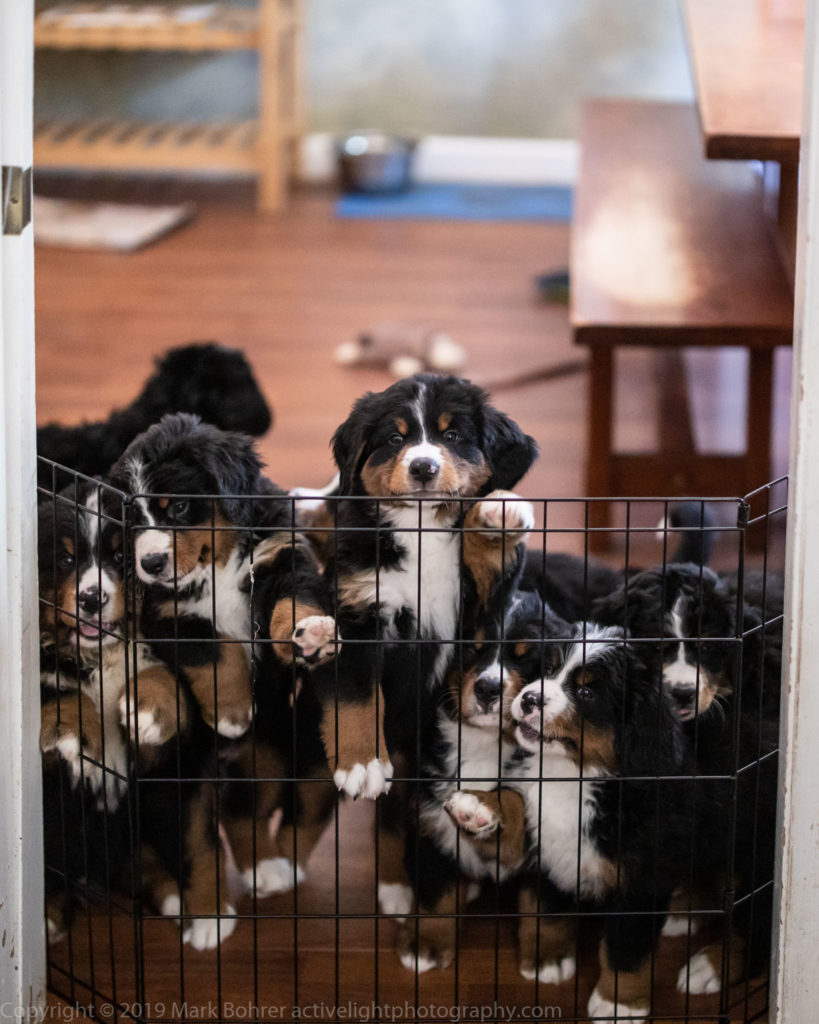 Stopped by the camera… We looped our way through Utah, southern Idaho and the Columbia River Gorge over to good friends’ 60th birthday party in Portland, Oregon. Then the plan was to head down to northern California to pick up an 8-week old puppy. But this wasn’t just any puppy. The Swiss Farmer’s Dog Bernese Mountain Dogs are far less common than breeds like Poodles and Labrador Retrievers. Originally Swiss farmers’ dogs, these big pups were bred to pull carts of cheese and milk to market and herd cattle. But mechanized farming put them out of use in the 1800s, and by the end of the 19th century there were very few left. A few dog fanciers rescued the remaining Berners from several Swiss valleys and began breeding them. Professor Albert Heim drove this effort in Switzerland, forming a Berner breed club there in 1907 and pushing the breed’s exhibition in shows. They started getting great press as a gentle companion dog, and their numbers grew. Berners made the trip to the US in 1926, and the rest, as they say, is history. 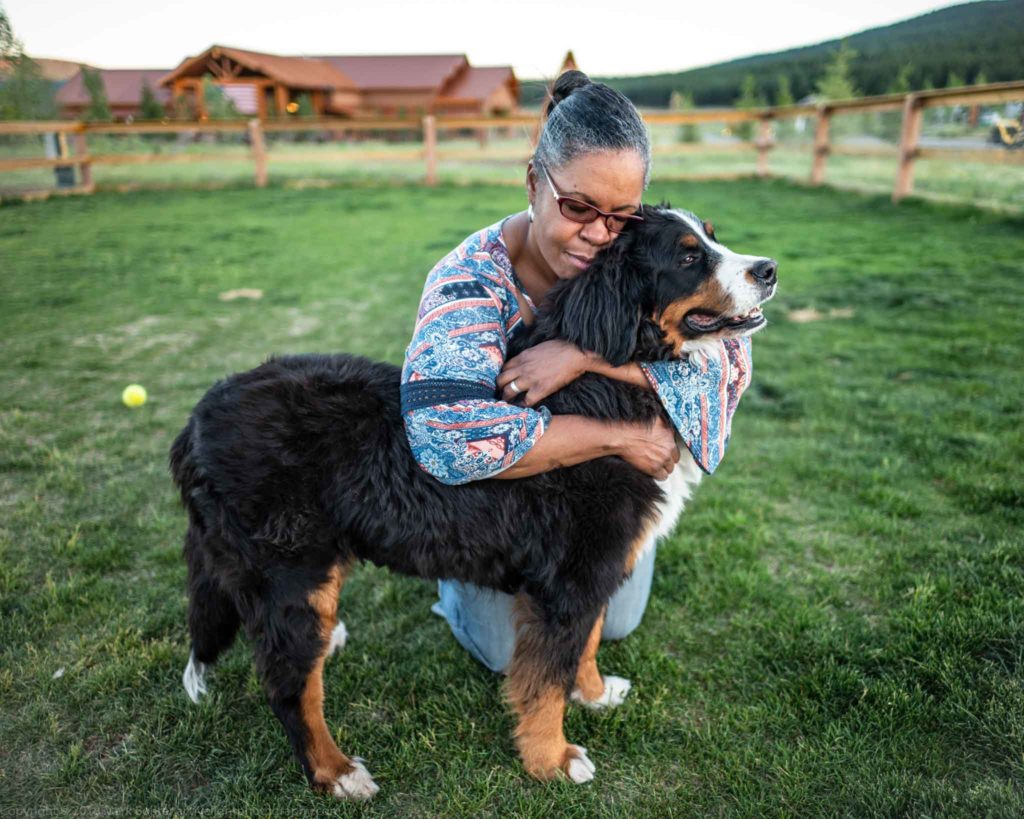 Daisy a few weeks before her passing 24mm f/1.4 Summilux-M ASPH Short Lifespans Our Berner Daisy developed cancer at age 5 1/2, in 2017. High rates of histiocytic sarcoma are one of the weaknesses of the breed. With aggressive chemotherapy and immune treatment at Veterinary Cancer Care of Santa Fe, NM, Daisy had another quality year with us, traveling to Idaho for the 2017 Solar Eclipse and elsewhere across the US west. Some Berners make it to 9, 10, or even 12 years old. Daisy was just unlucky. Berner Shopping Again A few months after Daisy’s passing in 2018, we began the search for a Berner puppy. We finally found an available litter in Carmichael, California, near Sacramento. This isn’t easy to do. There’s a fair amount of demand for these big, gentle dogs, and breeders only have so many litters. It can be a bit like adopting a child – you almost have to qualify for one. But we were lucky, so there we were in Carmichael in mid-June. When we picked up our first Berner Daisy in Paso Robles, California in August 2012, it was 107 F. So you’re thinking, “No problem, humans can handle that for a little while.” But Berners need a little more help. Their ancestors all came from a place where summertime high temperatures were around 75 F, and they really feel the heat. 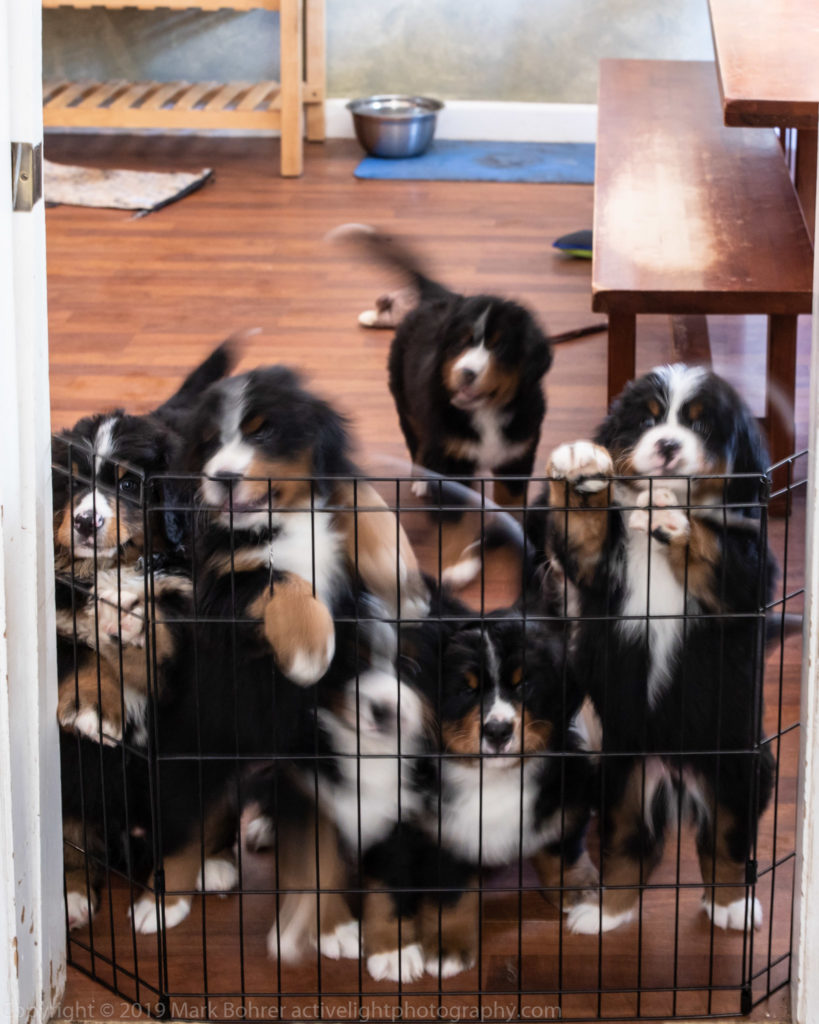 The litter as it really was… crazy energy RF 50mm f/1.2L, 1/10 sec at f/5.6 Crazy and NOT Just From the Heat Fast-forward to Carmichael in mid-June 2019. California was once again in the middle of a 100+ degree heatwave. I’m becoming convinced the only time we can pick up Berner pups is when it’s flaming hot. But our new pup Taylor took it all in stride… mostly. There was some whining, and it took a little while to work up a list of possible causes: 1. He’s thirsty. 2. He needs to pee. 3. He’s hungry. 4. He’s hot. 5. He misses us. 6. He misses his litter. Being hot was a common whine, quickly ended by entry to an air-conditioned space. And this litter was a handful. They climbed all over each other trying to greet us when we arrived at the breeder’s house. Naturally, Taylor was the first born and the alpha male of the group. But we’d asked for an outgoing pup, and that’s Taylor – confident, unafraid of anything, maybe a little pushy. 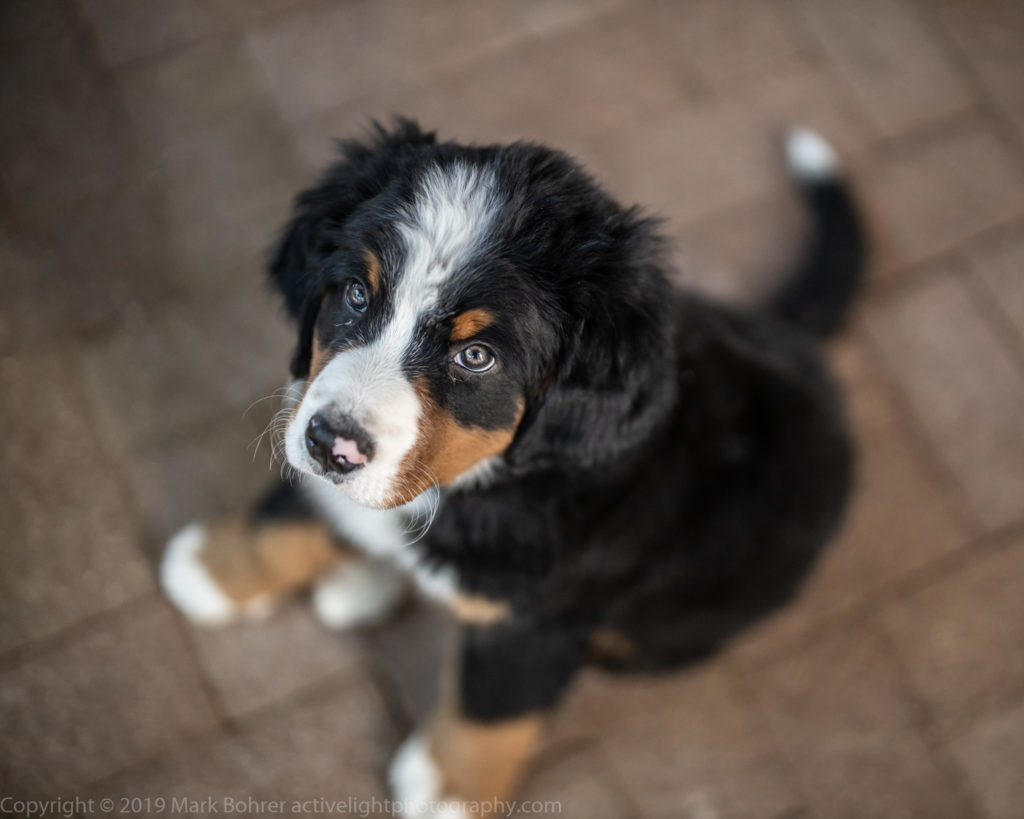 Taylor on the bricks RF 50mm f/1.2L During Daisy’s last year, it became very important to photograph her. I’ve continued that with our 14 year old Sheltie Buzz, and now with Taylor. Shots… er, Vaccinations It takes a few weeks for puppies to get their complete round of shots. They don’t usually finish the full shot program and gain full immunity until they’re 15-16 weeks old. But socialization’s also important in those first 16 weeks. 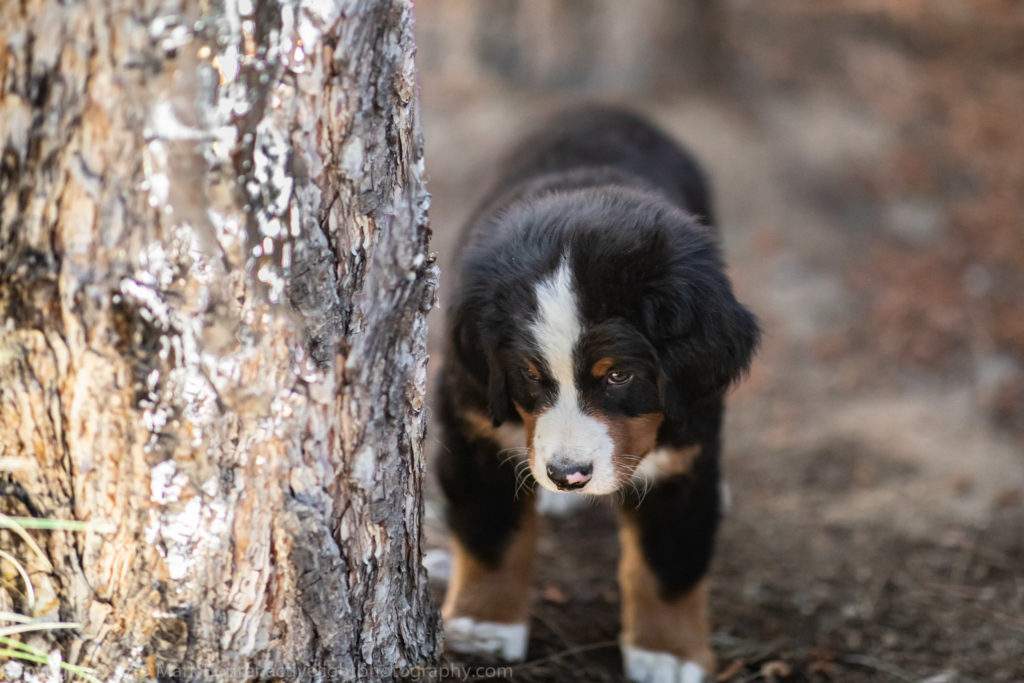 “Yes, I like trees…” EF 85mm f/1.4L IS So we’ve been careful who Taylor comes in contact with, but we’ve given him as much contact as we can. He’s met many of our human and dog friends with full immunity while he waits for his shots to be done. He’s also been to the backside summit of the Sandia Mountains, a cool 65 degrees when it’s in the 90s in Albuquerque down below. He rides the trails in his dog carriage to keep him isolated from any pathogens or other dogs. And he’s also been through Lowe’s, Petco and other local stores, again in his dog carriage. 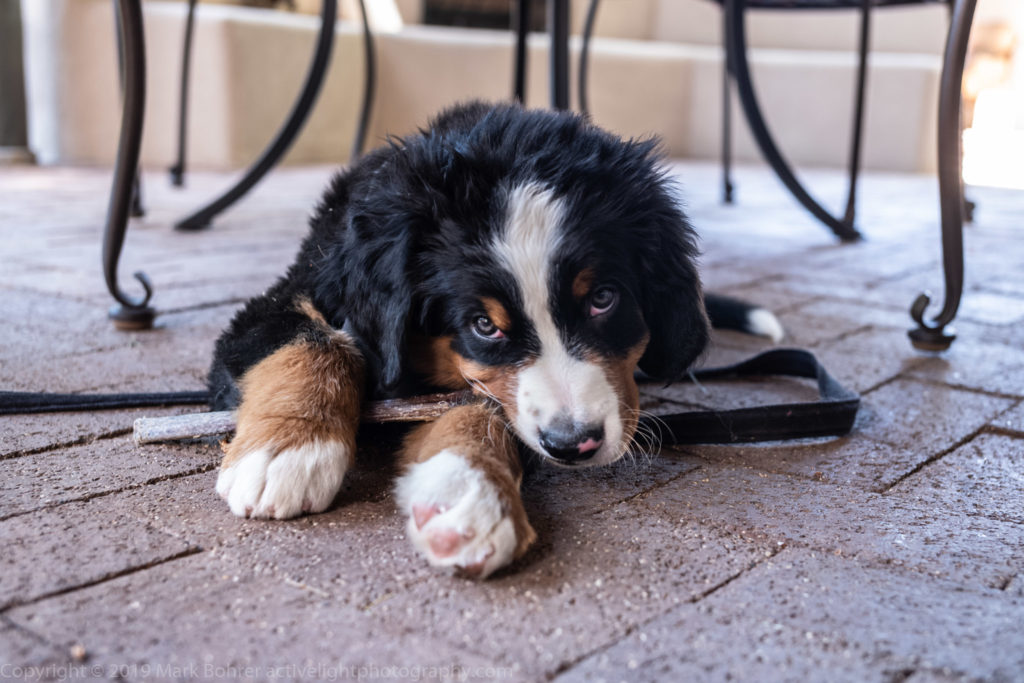 Chewing that bully stick 35mm f/2 Summicron-M ASPH But we’re looking forward to the day when he can run on leash. Yes, he’s cute to carry around now and hold on my lap, but he’s getting bigger and heavier… He gains around two pounds a week. I don’t know how much longer I can pick him up. Shot Notes When I’m shooting dogs for a client, my goal is to convince any viewer this dog is for them. That means playful poses, cute expressions, and sparkling eyes. I want to capture those things with my own dogs too. Showing puppies at their best is a a special challenge. They’re notoriously squirmy and nippy, and don’t stay put. Like photographing wildlife, you need to catch them while they’re distracted by something interesting. Toys can work, but most pups are food-driven. Even better if you can combine the two. Taylor loves chewing on bully sticks. Yes, he loves kibble treats too, but they don’t last long enough to be a good distraction. Bully sticks are food-like, but also have a satisfying chewy texture he loves. And they are relatively safe to chew, unlike nylabones or other treats that can come apart in splinters or chew down to large pieces that can be swallowed whole. So bully sticks are Taylor’s distraction of choice. I also wear him out with a walk or play session first. He’s a lot less squirmy after that. I like 50mm and 85mm lenses for dog action. They’re way more intimate than a 70-200mm will be at the longer focal lengths you’ll be tempted to use. On the other hand, I’ve also used 35mm lenses for play shots with two or three dogs. Yes, you can use manual focus with a 35mm or wider lens stopped down to f/5.6 or f/8 and ISO set to 1600 for action-stopping shutter speeds. The wide depth of field keeps most pup shots sharp if you pay attention to focus, and keep them moving laterally to your position. For 50mm or longer focal lengths, I prefer autofocus lenses. I never was that good at manual follow-focusing, whether it was with bike racers or wildlife. 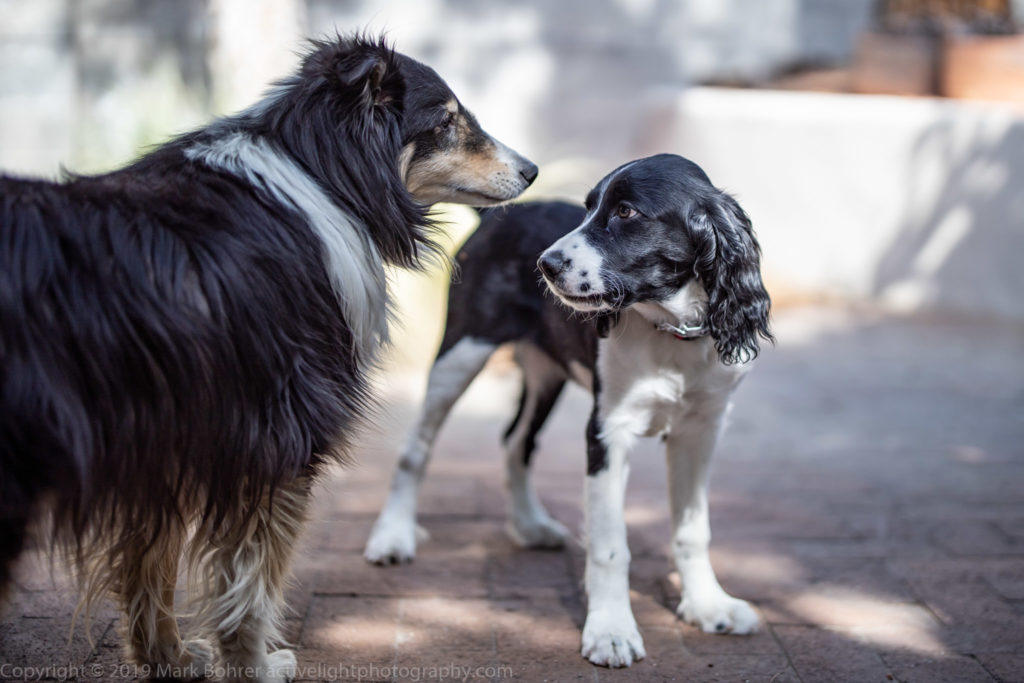 Buzz and playmate Carly RF 50mm f/1.2L, natural light My own personal style for action and some portraits is to isolate with depth of field. Canon’s RF 50mm f/1.2L for its EOS R mirrorless camera isolates very well at f/1.2 to f/2. I’ve ended up cropping sometimes when I don’t get close enough. But it’s generally easier to do that than use an 85mm lens and its narrower depth of field, though I have shot action with the EF 85/1.4L IS. I just have to manually track dog motion with the AF sensor point as close to the eye as possible. That will give the most acceptable-looking keepers. And the 85/1.4L IS works very well for dog portraits, as it does for humans. 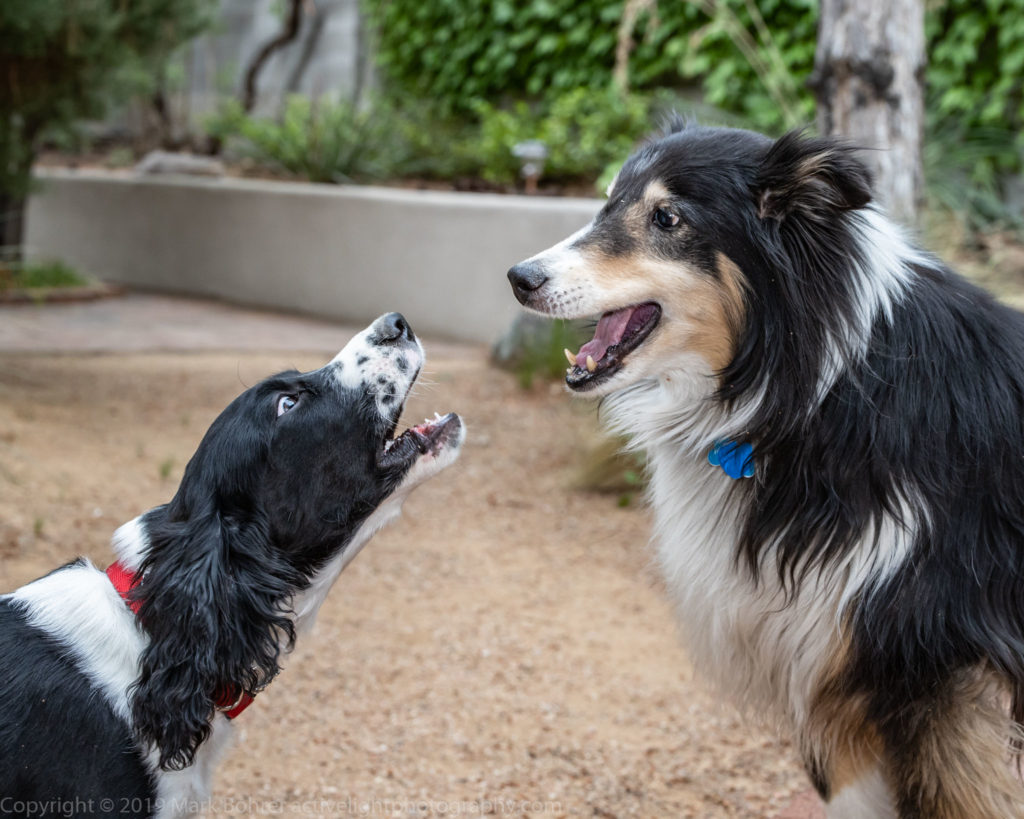 Carly and Buzz RF 50mm f/1.2L, 600EX II-RT flash I may also use fill flash in shadowed light or overcast to create a catchlight and fill dark fur. I have tri-colored dogs, with large areas of black and dark eyes, so fill is a definite help. I usually set the flash to underexpose -2/3 stop or so, to keep the shot from screaming “You used flash!” I’ll also set the camera exposure for -1/3 underexposure to avoid blowing out white fur highlights. More Information Berner.org (nd) history. Retrieved from http://www.berner.org/pages/some_basics/history.php Veterinary Cancer & Surgery Specialists (nd) Breeds and Cancer: Bernese Mountain Dogs and Histiocytic Sarcoma. Retrieved from http://www.vcsspdx.com/breeds-and-cancer-bernese-mountain-dogs-and-histiocytic-sarcoma/ Veterinary Cancer Care (nd) About Cancer. Retrieved from https://vetcancercare.com/about-cancer/ Swiss Star Farms (nd) Bernese Mountain Dogs. Retrieved from http://swissstarfarms.freeyellow.com/page8.html |
(408) 483-3782
Curious about how to shoot ruins?(408) 483-3782

Recent Comments